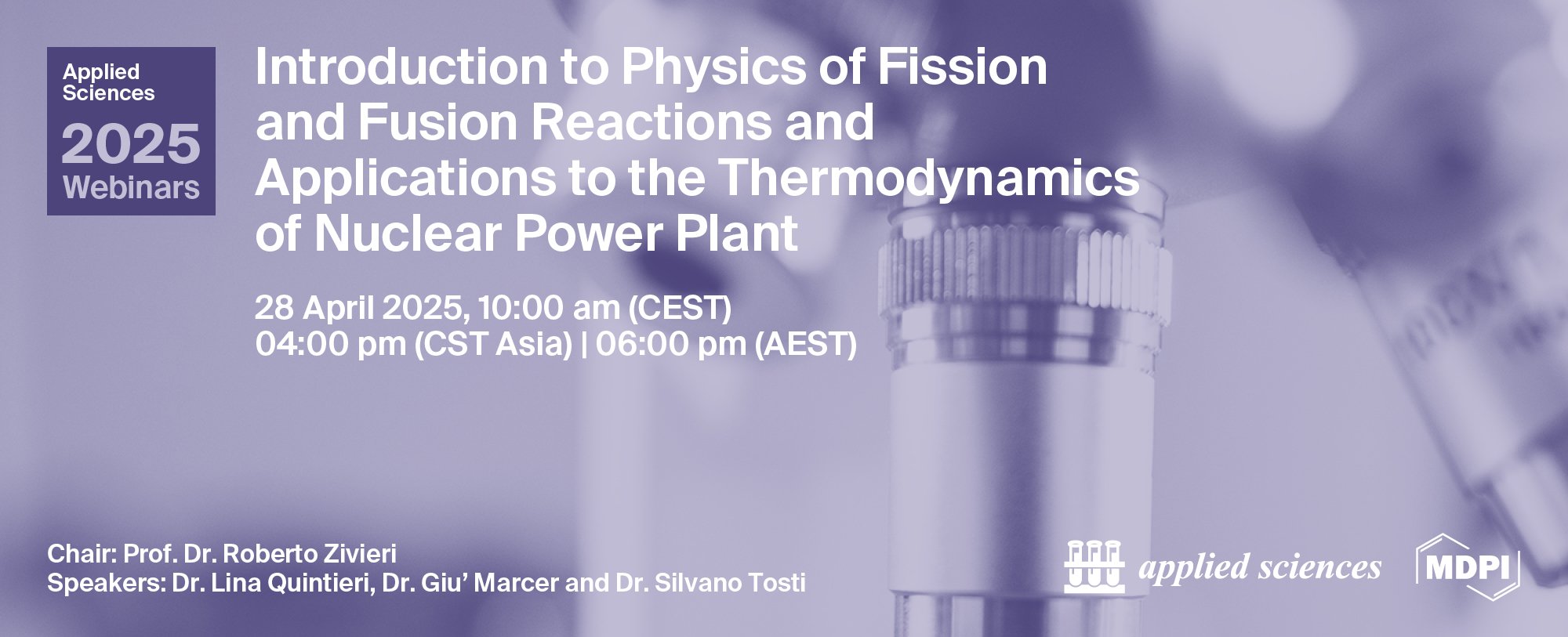Need Help?
22 April 2025
Applied Science Webinar | Introduction to Physics of Fission and Fusion Reactions and Applications to the Thermodynamics of Nuclear Power Plants, 28 April 2025

Message from the conference chair Dr. Roberto Zivieri:
It is my great pleasure to welcome both speakers and attendees to this webinar titled “Introduction to Physics of Fission and Fusion Reactions and Applications to the Thermodynamics of Nuclear Power Plants”. The speakers are leading experts on the topic and will deliver talks on the fundamentals of fission and fusion processes, the related underlying thermodynamics, and the key engineering and technological applications. Recent advancements in nuclear fission technologies reflect growing global interest in safer, more flexible, and more sustainable nuclear energy systems.
The first talk will provide an accessible yet scientifically grounded overview of the fundamental principles of nuclear physics underlying fission processes. Key nuclear physics concepts relevant to fission, such as binding energy, neutron-induced reactions, and the mechanism of a self-sustaining chain reaction, will be introduced. Particular emphasis will be placed on how energy is released in nuclear fission and the physical conditions necessary for maintaining controlled reactions within power-generating systems.
The second talk introduces the topic of fusion reactions from an energetic perspective. In nuclear physics, the spontaneity analysis of these reactions relies on assessing their exothermicity (the amount of energy defined by the Q-value) and the reaction rate (the number of reactions per unit time and per unit volume). Particular emphasis will be placed on the main challenges for future research and the open questions across both physics and engineering.
In the third talk, nuclear processes will be discussed through a classical thermodynamic approach. Compared to the nuclear physics analysis, engineering thermodynamics considers the change in entropy, a parameter that has been neglected thus far. It is important to highlight that entropy plays a different role across fission (ΔS > 0) and fusion (ΔS < 0) reactions. While fission reactions are always spontaneous, regardless of the temperature, in fusion reactions, the temperature acts as a very powerful amplifier of the entropic term (- TΔS) that, at a very high temperature, may significantly reduce the thermodynamic spontaneity of these processes.
In general, in fusion reactions at very high temperatures (such as that adopted in the tokamaks, i.e., around 108 K), a share of the Q-value is consumed to balance the entropic term (−T ΔS), thus reducing the enormous amount of energy made available by a nuclear fusion process. Such an aspect could have a non-negligible impact on the energy efficiency of the fusion systems and should be considered in future tokamak designs.
Keywords: fusion reactions; fission reactions; nuclear reaction entropy
Date: 28 April 2025 10:00 a.m. CEST | 4:00 p.m. CST Asia | 6:00 p.m. AEST
Webinar ID: 893 8595 5371
Register now for free!
|
Speaker/Presentation |
CEST |
CST (Asia) |
|
Dr. Roberto Zivieri |
10:00–10:10 a.m. |
4:00–4:10 p.m. |
|
Dr. Lina Quintieri |
10:10–10:30 a.m. |
4:10–4:30 p.m. |
|
Q&A Session |
10:30–10:40 a.m. |
4:30–4:40 p.m. |
|
Dr. Giù Marcer |
10:40–11:00 a.m. |
4:40–5:00 p.m. |
|
Q&A Session |
11:00–11:10 a.m. |
5:00–5:10 p.m. |
|
Prof. Silvano Tosti |
11:10–11:30 a.m. |
5:10–5:30 p.m. |
|
Q&A Session |
11:30–11:40 a.m. |
5:30–5:40 p.m. |
|
Dr. Roberto Zivieri |
11:40–11:50 a.m. |
5:40–5:50 p.m. |
After registering, you will receive a confirmation email on how to join the webinar. Registrations with academic institutional email addresses will be prioritized.
Unable to attend? Register anyway and we will let you know when the recording is available to view.
Webinar Chair and Keynote Speakers:
- Dr. Roberto Zivieri, Department of Engineering, University of Messina, Messina, Italy;
- Dr. Lina Quintieri, Rutherford Appleton Laboratory, Chilton, Oxon, UK;
- Dr. Giù Marcer, Institute for Plasma Science and Technology (ISTP) of the National Research Council (CNR), Italy;
- Dr. Silvano Tosti, Nuclear Department, ENEA, Frascati, Italy.

